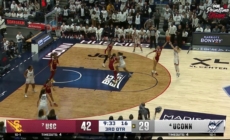-
An angry Lamar Jackson helps Ravens clinch as Tom Brady’s LFG Player of the Game - 15 mins ago
-
Giants Predicted To Steal Mets’ Pete Alonso In Free Agency - 44 mins ago
-
Juju Watkins blocks Paige Bueckers and lays it up on the other end, extending USC’s lead vs. UConn - 58 mins ago
-
Former NASCAR Driver Confirms Full-Time Racing Return In 2025 - about 1 hour ago
-
Tom Brady’s LFG Player of the Game for Week 16: Ravens QB Lamar Jackson - 2 hours ago
-
Chandler Smith Secures Full-Time NASCAR Drive After Joe Gibbs Racing Exit - 2 hours ago
-
Tom Brady praises Lamar Jackson & Derrick Henry in Ravens' win vs. Steelers | NFL on FOX - 2 hours ago
-
At least 5 killed, 200 injured after car plows into Christmas market in Germany - 3 hours ago
-
Was Rickey Henderson Greatest MLB Player of All Time? Where Does He Rank? - 3 hours ago
-
Tom Brady is fired up by Ravens CB Marlon Humphrey's 37-yard pick-six vs. Steelers | NFL Highlights - 3 hours ago
L.A.’s promise of “car free” Olympics running short on time and money
With Los Angeles Olympics four years away and no detailed transportation plans yet, officials are concerned about a lack of money and time to create the “car free” Games that Mayor Karen Bass has promised.
Local officials have a litany of projects they want to complete ahead of 2028, from adding charging infrastructure to improving Metro stations close to venues, but so far attempts to secure federal funds have been hit-and-miss.
The Los Angeles Metropolitan Transportation Authority’s $3.3-billion list of projects needed to make the games run smoothly is 5.2% funded. If the money doesn’t come through soon, transit planners predict some critical projects may be scuttled — making it tougher for visitors and regular commuters to get around town.
The games are expected to bring an onslaught of tourists — a crowd equivalent of seven Superbowls every day of the Olympics. And policymakers are starting to get nervous as the clock ticks.
Metro board chair and county Supervisor Janice Hahn, who attended the closing ceremony in Paris and spent days observing their operations, is calling for a fresh Olympic transportation plan that includes staffing levels, total estimated cost and a coordination strategy across the region. It’s a plan that so far has been lacking, with no single agency in charge.
“Millions of people are going to attend the Olympic and Paralympic Games in 2028 and it is going to be Metro’s responsibility to move hundreds of thousands of them every day quickly and efficiently to and from venues across the county every day,” Hahn said. “This is going to be a heavy lift for Metro.”
The Metro board will probably vote on whether to enact it, but even with the political will, an immediate plan is not totally possible. That’s because Olympic organizers still haven’t released the full venue list.
“We have less than four years and we need to see a plan for how we are going to find enough buses, train enough bus drivers, and get our system ready,” she said.
Metro’s planners are also suggesting that the board provide an additional $10 million to jump-start some Olympic efforts.
The task is “daunting,” said Juan Matute, deputy director of UCLA’s Institute of Transportation Studies, who earlier this month organized a symposium with policymakers, advocates, academics and planners on the upcoming Olympics.
“There’s still so much uncertainty,” he said. The Olympic and Paralympic organizing committee, “as an organization, has lost sponsors and is underfunded, and they have to go around the venue city as part of the agreement to try to get the cities to take on more of the security costs.”
That group putting on the $7-billion sports event, LA28, said it was still $1 billion short of hoped-for sponsorships last year, but it has not released new financial details recently.
Whether or not it can raise enough funds for the venues, the group is not paying for public transportation and the interlocking system of rail, van and bus routes Metro wants to create to ferry tens of thousands of tourists across dozens of miles. LA28 only foots the bill for a transit system for athletes and game personnel. Both are dialing back on the car-free promise, saying that these Games will be transit-first.
But the Games will have to be somewhat car-free because there will be no public parking at or near most Game venues due largely to federal security restrictions.
LA28 will continue working with public agencies to “identify how those projects fit with the LA28 Games transportation plan … while also keeping the region’s residents and businesses moving reliably,” said Sam Morrissey, LA28 Vice President of Transportation.
So far, 34 of the 50 Olympic sport venues have been confirmed. LA28 does not expect the entire list to be finalized until next year.
Judo; diving; rhythmic, artistic and trampoline gymnastics; fencing; and table tennis are among a dozen that will be clustered in or near downtown Los Angeles, the most transit rich-pocket in Southern California, with multiple rail and bus lines converging.
Metro itself bragged on Instagram the day the Olympic flag arrived in Los Angeles from Paris about its rail system’s proximity to venues, hinting that “nearly all of the venues announced so far are already near or close to our (rail) system.”
The A and E line are within close walking distance of the venues. And in Long Beach, where the A Line ends, eight sports will be played — rowing, sailing, triathlon, water polo, canoe sprint, artistic swimming, marathon swimming and handball. SoFi Stadium, which is set to host basketball and swimming, is about a half-hour walk from the K Line.
But Los Angeles is not Paris. The European city’s more-than-a-century-old subway became the transit workhorse of the Olympic Games, with trains pulling in every few minutes emptying out crowded stations and moving spectators quickly from stadiums and pop-up venues.
“That really kept the crowds moving, particularly after an event ended, how quickly the trains came,” Hahn said. “They were coming every 90 seconds, maybe every two minutes.”
The peak capacity of L.A.’s subway trains is about 1,500 people, while shorter light rail trains carry fewer riders. So, officials are trying to come up with a plan to keep people busy at venues after the events finish so not everybody rushes to get on buses or trains. Planners are looking at pop-up restaurants, street vendors and other experiences to keep spectators engaged.
The workhorse of the L.A. Olympics will likely be buses. Metro officials estimate that creating a supplemental bus system for the Games could cost up to $1 billion, and they have yet to identify how to pay for it.
“By the time 2028 rolls around,” Metro’s Instagram post said. “There will be additional bus shuttles, bus lanes and other key projects and upgrades to make the Games easy on visitors and residents.”
Matute, of UCLA, thinks that if plans aren’t ironed out, venues could be inundated with Ubers and Lyfts as fans rush to leave events.
Last week scores of government workers from Metro, the Los Angeles Department of Transportation, the California Highway Patrol and other agencies crowded into a small conference room to hear from Paris officials and others about Olympic planning during a two-day summit.
Bass’ office barred the media from covering the panels, but Paris officials and others were trying to impress upon employees the level of urgency planning must take.
“The city has obsolete technology, severe staff shortages and more priorities than it can possibly accomplish,” said one city official not authorized to talk outside of the post-Paris summit.
No amount of planning will help without funds.
For the 2002 Winter Olympics in Salt Lake City, planners already had secured transportation funds four years out, said Seleta Reynolds, Metro’s chief innovation officer who has been leading the Olympic efforts for the agency.
That’s because, previous Olympics got federal commitments. The Biden administration hasn’t made any significant commitments to the Los Angeles Olympics so far. And right now, officials are eyeing the elections to see who will occupy the White House, hoping that they can make a further appeal to the incoming administration.
“They could proceed with a lot more clarity and certainty than than we are,” Reynolds said. “We’re having to walk, chew gum, swim and build an airplane at the same time, because there’s so many different potential scenarios here.”
Times staff writer Dakota Smith contributed to this story.
Source link






























